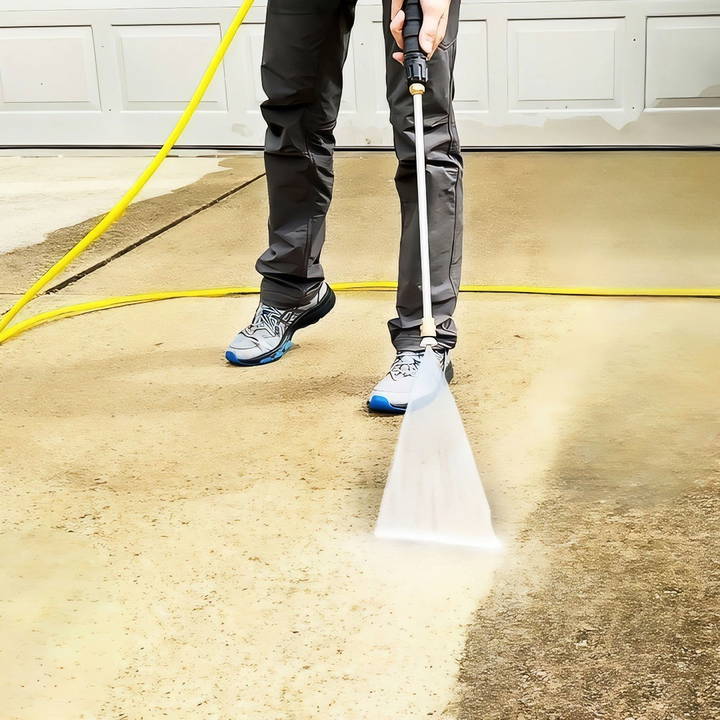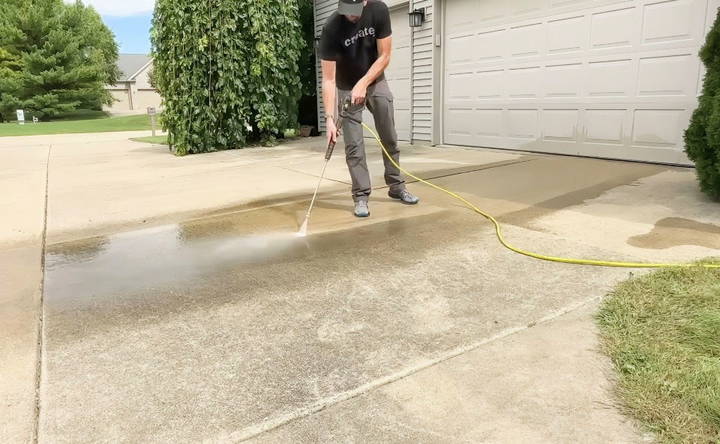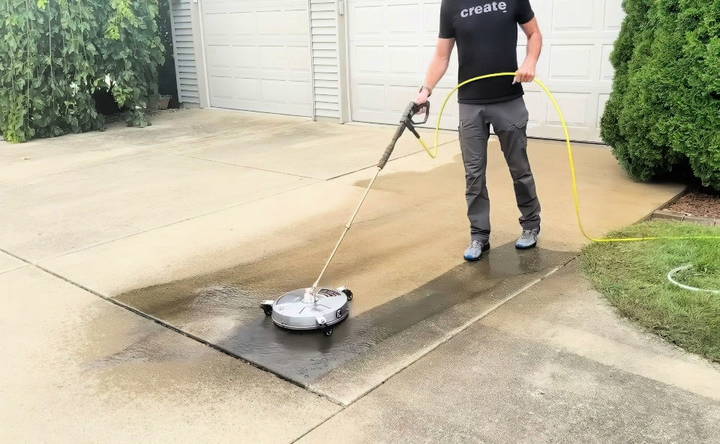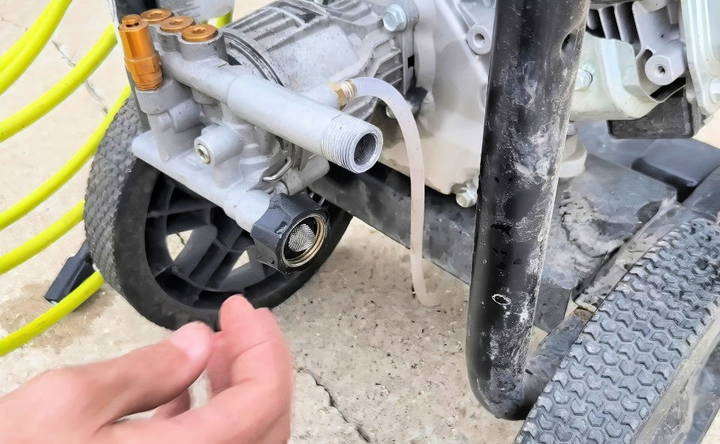How To Pressure Wash A Driveway: Pro Tips for Best Results (original) (raw)
Cleaning a concrete driveway can seem like a daunting task, especially when dealing with built-up dirt, debris, and stains. I've gone through this process multiple times and learned some key steps to make the job faster and more effective. In this guide, I'll take you through how to pressure wash a driveway using the right equipment, techniques, and a solid plan of attack.

Why Start at the Highest Point of the Driveway?
When pressure washing a driveway, the first step is understanding how water and debris will flow. One mistake I made early on was starting at a low point, which led to dirt running over already-cleaned areas. This added more work and frustration.
Instead, it's critical to start at the highest point of the driveway and work your way down. This way, any debris, mud, or dirt you remove flows down to an unclean area, making the job easier and keeping your freshly cleaned sections spotless.
Selecting the Right Equipment
Learn how to select the right pressure washer and surface cleaner for optimal cleaning. Learn why the surface cleaner is a game-changer.
The Pressure Washer
The core tool for this job is a good pressure washer. I use a Simpson 3100 PSI pressure washer, which delivers 2.3 gallons per minute. This model strikes a good balance between power and price. I picked it up for about $350, and it's been reliable for cleaning concrete, decks, and siding around my home.
While electric pressure washers are tempting for their simplicity, they just don't have the power of gas models like mine. The electric versions might hit 300 PSI, but they usually fall short in flow rate, making larger cleaning jobs harder. If you're dealing with a big, dirty driveway, gas pressure washers provide the necessary force and volume of water to tackle stubborn stains.
The Surface Cleaner: A Game Changer
One of the best investments I've made for cleaning concrete is a 15-inch surface cleaner. If you've ever tried to clean an entire driveway using just a wand, you know how exhausting and time-consuming it can be.
Surface cleaners attach to your pressure washer and have rotating nozzles that ensure an even clean. The three wheels on my model keep the cleaner at a consistent height, which helps avoid uneven cleaning and those annoying wave patterns you might get with a wand. This tool speeds up the process significantly, allowing me to clean my 1800-square-foot driveway in less than two hours.
I got mine for around $100, and it's worth every penny for the time and effort it saves.
Step by Step Instructions
Learn how to pressure wash a driveway step by step, with tips on equipment, preparation, and maintenance for a perfect clean.
1. Planning and Preparation
Before starting, I always plan my approach. I make sure to have all my equipment ready: pressure washer, surface cleaner, and extra nozzles (just in case). Additionally, I ensure the driveway is free from any large debris that could interfere with the cleaning process.
Starting at the top of the driveway and working downward allows me to clean efficiently without having to redo any sections.
2. First Pass with the Surface Cleaner
The first pass with the surface cleaner is where the heavy lifting happens. I push it smoothly across the driveway, letting the rotating nozzles break up dirt and grime. I do this methodically, making sure to overlap slightly with each pass to avoid missing spots. The key here is maintaining a steady pace to ensure even cleaning across the surface.

3. Secondary Cleaning with the Wand
Once I've made an initial pass with the surface cleaner, I follow up with my pressure washer wand, fitted with a 40-degree nozzle. This helps me clear away any remaining dirt, mud, or debris that the surface cleaner loosened but didn't fully remove. I also use this step to target stubborn spots or areas that need a little extra attention.
4. Final Touches: Dealing with Stains
If your driveway has oil stains or heavy mildew like mine sometimes does, the wand can come in handy. I keep both 15-degree and 40-degree nozzles in my pocket to switch out when needed. A degreaser can also help with oil stains. Scrubbing it in before washing can improve results, but thankfully, my driveway was clear of oil during my last clean-up.

Important Attachments
While the surface cleaner does most of the work, the wand remains an important tool for detail work. I recommend having a 40-degree nozzle for general cleaning and a 15-degree nozzle for tougher spots. You'll find that these two options can handle almost any surface dirt or stains that remain after using the surface cleaner.
Fuel and Time Considerations
To give you an idea of the overall time commitment and fuel usage, cleaning my 1800-square-foot driveway took me just under two hours and about 1.5 gallons of gas. This is a reasonable expectation for most standard driveways, though larger or more complex layouts may take longer.
The gas usage is something to keep in mind, especially if you're planning to clean multiple areas or larger surfaces.
Pump Maintenance and Storage Tips
After spending the time and energy cleaning your driveway, the last thing you want is for your pressure washer to break down. One mistake I made early on was neglecting to use a pump saver before storing my machine. Over time, the seals inside the pump can corrode if they're left dry for months.

To avoid this, I always use a pump-saver solution when I'm done. It's simple: attach the pump saver to the pressure washer's hose inlet, press until the liquid flows out of the high-pressure outlet, and you're done. This small step can extend the life of your pressure washer significantly.
Renting vs. Buying Equipment
If you don't have a pressure washer or surface cleaner, you might be wondering whether to buy or rent. Renting can cost between 130and130 and 130and150 a day for both the pressure washer and surface cleaner. For occasional projects, this can be a reasonable option.
However, if you see yourself needing a pressure washer for future tasks, I recommend buying your own. I spent 350onmySimpson3100PSIpressurewasherand350 on my Simpson 3100 PSI pressure washer and 350onmySimpson3100PSIpressurewasherand100 on my surface cleaner. Given how frequently I use it, the purchase has paid for itself in time and convenience.
Common Mistakes to Avoid
When pressure washing a driveway, it's easy to make mistakes that can lead to damage or ineffective cleaning. Here are some common mistakes to avoid:
Using Too Much Pressure
One of the biggest mistakes is using too much pressure. High pressure can damage the surface of your driveway, especially if it's made of concrete or asphalt. Always start with a lower pressure setting and increase it gradually if needed.
Incorrect Nozzle Selection
Using the wrong nozzle can lead to poor cleaning results or damage. Nozzles come in different angles, such as 0°, 15°, 25°, and 40°. A 0° nozzle is very powerful and can cause damage, while a 40° nozzle is gentler and better for general cleaning. Choose the right nozzle for the job.
Overlapping Strokes
Avoid overlapping your cleaning strokes too much. Overlapping can cause streaks and uneven cleaning. Instead, use a consistent, side-to-side motion, and make sure each pass slightly overlaps the previous one to ensure even coverage.
Ignoring Safety Precautions
Safety is crucial when using a pressure washer. Always wear protective gear, such as safety glasses, gloves, and sturdy shoes. Be aware of your surroundings and keep children and pets away from the area.
Not Pre-Treating Stains
For tough stains like oil or grease, pre-treating is essential. Use a degreaser or a specialized cleaner to break down the stain before pressure washing. This will make the cleaning process more effective.
Skipping Surface Inspection
Before you start, inspect the driveway for cracks or loose concrete. High pressure can worsen these issues. Repair any damage before pressure washing to avoid further problems.
Inadequate Water Supply
Ensure your water supply is adequate for the pressure washer. A low water flow can cause the machine to work inefficiently and may lead to damage. Check the manufacturer's recommendations for the required water flow rate.
Improper Cleaning Technique
Using the wrong technique can result in poor cleaning and potential damage. Hold the pressure washer nozzle at a consistent distance from the surface, usually about 12-18 inches. Move the nozzle in a steady, sweeping motion to avoid concentrating the pressure in one spot.
Neglecting Post-Wash Maintenance
After washing, it's important to maintain your driveway. Consider applying a sealant to protect the surface from future stains and damage. Also, clean and store your pressure washer properly to ensure it remains in good working condition.
By avoiding these common mistakes, you can ensure a thorough and safe cleaning of your driveway.
Safety Precautions
When pressure washing a driveway, safety should be your top priority. Here are some essential safety precautions to follow:
Wear Protective Gear
Always wear the right protective gear to keep yourself safe. This includes:
- Safety Glasses: Protect your eyes from debris and water spray.
- Gloves: Wear sturdy gloves to protect your hands from chemicals and high-pressure water.
- Sturdy Footwear: Use closed-toe shoes with a good grip to prevent slips and protect your feet.
Be Mindful of Your Surroundings
Before you start, make sure the area is clear of children, pets, and any obstacles. Pressure washers can cause serious injuries, so it's important to keep others at a safe distance.
Use the Right Equipment
Ensure you are using the correct pressure washer for the job. Check the manufacturer's instructions for the recommended pressure settings and nozzle types. Using the wrong equipment can lead to accidents or damage.
Handle Chemicals with Care
If you're using cleaning solutions, handle them with care. Always read the labels and follow the instructions. Wear gloves and avoid inhaling fumes. Store chemicals safely out of reach of children and pets.
Inspect the Area
Before you begin, inspect the driveway for any cracks or loose materials. High-pressure water can worsen these issues. Repair any damage before pressure washing to avoid further problems.
Maintain a Safe Distance
Keep the pressure washer nozzle at a safe distance from the surface you're cleaning. Typically, 12-18 inches is a good range. Holding the nozzle too close can damage the surface and cause debris to fly back at you.
Avoid Electrical Hazards
Be cautious around electrical outlets and fixtures. Water and electricity are a dangerous combination. Use a ground fault circuit interrupter (GFCI) outlet for added safety, and never point the pressure washer at electrical components.
Follow Proper Technique
Use a steady, sweeping motion when pressure washing. Avoid concentrating the spray in one spot for too long, as this can damage the surface. Move the nozzle in a consistent pattern to ensure even cleaning.
Turn Off the Machine Properly
When you're finished, turn off the pressure washer according to the manufacturer's instructions. Release any built-up pressure in the hose before disconnecting it. Store the equipment in a safe, dry place.
Stay Informed
Stay updated on the latest safety guidelines and best practices for pressure washing. Regularly check the manufacturer's website for any updates or recalls related to your equipment.
By following these safety precautions, you can ensure a safe and effective pressure-washing experience.
FAQs About Pressure Washing a Driveway
FAQs About Pressure Washing a Driveway
1. What is pressure washing?
Pressure washing uses high-pressure water to remove dirt, grime, and stains from surfaces like driveways. It's an effective way to clean and maintain your driveway.
2. What type of pressure washer should I use?
For concrete driveways, use a pressure washer with at least 1500 PSI. Gas-powered washers are generally more powerful and effective for tough stains.
3. What is the best technique for pressure washing a driveway?
Start from the highest point of the driveway and work your way down. Use a sweeping motion, overlapping each pass slightly to ensure even cleaning.
4. How do I remove stubborn stains?
For tough stains like oil or grease, apply a degreaser and scrub it with a brush before pressure washing. You can also use a more concentrated spray with a narrower nozzle.
5. How do I avoid damaging my driveway?
Keep the nozzle at least 12 inches away from the surface to prevent damage. Use the appropriate nozzle for the job, and avoid using too much pressure on delicate areas.
Final Thoughts
Pressure washing your driveway can transform its appearance, making it look like new. The right equipment—especially a surface cleaner—can make the job quicker and more efficient, leaving you with professional-grade results.
Whether you're tackling a small area or an expansive driveway, having a plan and the proper tools will make all the difference. And remember, a little maintenance on your equipment can save you headaches down the road.